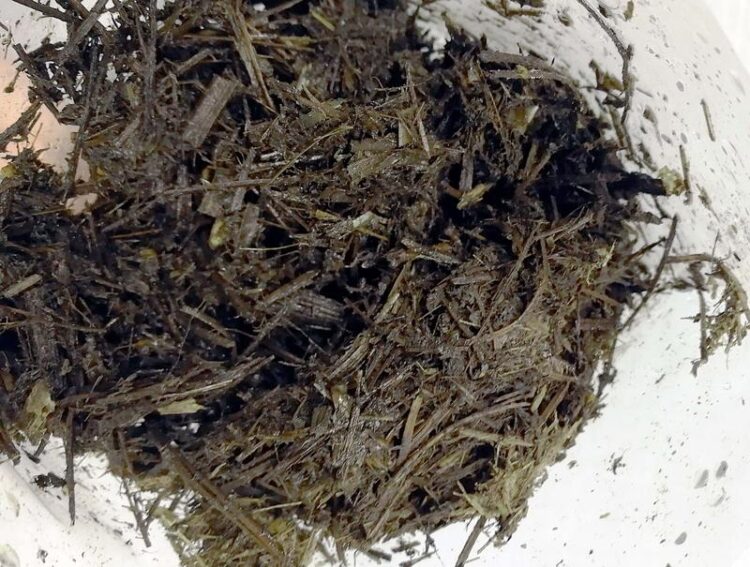Furniture from the biogas plant

Unwashed biogas digestate
(c) DITF
The Hallertau is Germany’s largest hop-growing region. During harvesting, hop bine chaff is left over, which is converted into environmentally friendly bio natural gas on site in a biogas plant. But that is not the end of the utilization chain for this fiber plant. Researchers at the German Institutes of Textile and Fiber Research Denkendorf (DITF) have used the plant-containing biogas digestate to produce a composite material that can be used to make furniture.
Laminates are in great demand in the furniture industry because they can be designed very flexibly. The composite material made from biogas digestate developed at the DITF with their project partners is a particularly sustainable variant. To produce it, these plant-based residues are first cleaned in an environmentally-friendly way. From this mass, the DITF and Reutlingen University have developed a wet laid nonwoven that is pressed together with a bio-based resin system to form a composite material. It is load-bearing and can be processed in a variety of ways. The project group has created an initial demonstrator from the material.
The project is an example of successful circular economy and value creation. Using biogas digestate as an industrial raw material is an environmentally-friendly alternative to their previous use as fertilizer, which increases nitrate pollution of the soil and is also significantly restricted by new regulations. Chemical additives are deliberately avoided in the production process, and if offcuts from the textile industry are also used in the design of the furniture, this results not only in unusual designs but also in further added value for the environment.
The research project was funded as part of the Central Innovation Program for SMEs (ZIM). The project partners were Hopfenpower GmbH, Novis GmbH and the joinery Nuding.
Wissenschaftliche Ansprechpartner:
Prof. Dr.-Ing. Markus Milwich
Deputy Head of Competence Center Polymers & Fiber Composites
Head of Fiber Composite Technology
T +49 (0)711 93 40-164
E markus.milwich@ditf.de
Media Contact
All latest news from the category: Ecology, The Environment and Conservation
This complex theme deals primarily with interactions between organisms and the environmental factors that impact them, but to a greater extent between individual inanimate environmental factors.
innovations-report offers informative reports and articles on topics such as climate protection, landscape conservation, ecological systems, wildlife and nature parks and ecosystem efficiency and balance.
Newest articles

How marine worms regenerate lost body parts
The return of cells to a stem cell-like state as the key to regeneration. Many living organisms are able to regenerate damaged or lost tissue, but why some are particularly…

Nano-scale molecular detective
New on-chip device uses exotic light rays in 2D material to detect molecules. Researchers have developed a highly sensitive detector for identifying molecules via their infrared vibrational “fingerprint”. Published in Nature…

Novel CAR T-cell therapy
… demonstrates efficacy and safety in preclinical models of HER2-positive solid tumors. The p95HER2 protein is found expressed in one third of HER2+ tumors, which represent 4% of all tumors….



